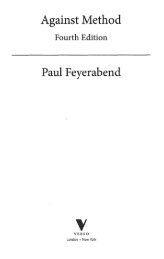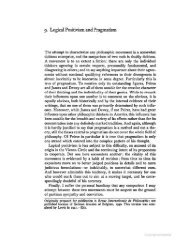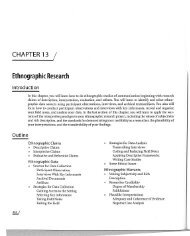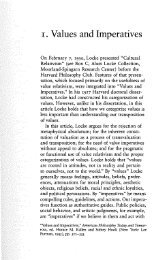In defence of the value free ideal
In defence of the value free ideal
In defence of the value free ideal
- No tags were found...
You also want an ePaper? Increase the reach of your titles
YUMPU automatically turns print PDFs into web optimized ePapers that Google loves.
Euro Jnl Phil SciTable 1 Types <strong>of</strong> uncertainty or knowledge states that require a specific articulation <strong>of</strong> <strong>the</strong> results andfindings in scientific policy adviceState <strong>of</strong> scientific understandingA) A variable is ambiguous, or <strong>the</strong> processes determining it are poorly knownor not amenable to measurement.B) The sign <strong>of</strong> a variable can be identified but <strong>the</strong> magnitude is poorly known.C) An order <strong>of</strong> magnitude can be given for a variable.D) A range can be given for a variable, based on quantitative analysisor expert judgment.E) A likelihood or probability can be determined for a variable, for <strong>the</strong> occurrence<strong>of</strong> an event, or for a range <strong>of</strong> outcomes (e.g., based on multiple observations,model ensemble runs, or expert judgment).F) A probability distribution or a set <strong>of</strong> distributions can be determinedfor <strong>the</strong> variable ei<strong>the</strong>r through statistical analysis orthrough use <strong>of</strong> a formal quantitative survey <strong>of</strong> expert views.Adapted from Mastrandrea et al. (2010)and provides a counter-example to <strong>the</strong> arbitrariness <strong>the</strong>sis (Thesis 1), underpinning<strong>the</strong> refutation <strong>of</strong> <strong>the</strong> methodological critique.The Guidance Note distinguishes six epistemic states that characterize differentlevels <strong>of</strong> scientific understanding, and lack <strong>the</strong>re<strong>of</strong>, pertaining to some aspect <strong>of</strong> <strong>the</strong>climate system, as shown in Table 1. For each <strong>of</strong> <strong>the</strong>se epistemic states, <strong>the</strong> GuidanceNote suggests which sort <strong>of</strong> statements may serve as appropriate explications <strong>of</strong> <strong>the</strong>available scientific knowledge. Thus, in case F), it advises to state <strong>the</strong> probability distribution(while making <strong>the</strong> assumptions <strong>of</strong> <strong>the</strong> statistical analysis explicit), whereasin case C), it does not do so. 28From state A) to state F), <strong>the</strong> scientific understanding gradually increases, and <strong>the</strong>statements scientists can justifiably and reliably make become ever more informativeand precise. If, as is <strong>the</strong> case in state A), current understanding is very poor, scientistsmight simply report that very fact, ra<strong>the</strong>r than dealing with significant inductiverisks when inferring some far-reaching hypo<strong>the</strong>sis (as <strong>the</strong> methodological critiquehas it). Importantly, <strong>the</strong> statement that a process is poorly understood, that <strong>the</strong> evidenceis low and that <strong>the</strong> agreement amongst experts is limited—such a statementitself does not involve any practically significant and policy-relevant uncertainties(contra premiss P2’). The Guidance Note thus provides a blueprint for making uncer-28 Note that, according to <strong>the</strong> Guidance Note, <strong>the</strong> explication <strong>of</strong> uncertainties does not necessarily dependon “our best climate models”, as Winsberg (2010, p. 111) assumes.






